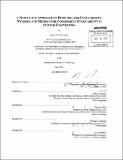A normative approach to designing for evolvability : methods and metrics for considering evolvability in systems engineering
Author(s)
Fulcoly, Daniel O'Brien
DownloadFull printable version (13.02Mb)
Other Contributors
Massachusetts Institute of Technology. Dept. of Aeronautics and Astronautics.
Advisor
Donna H. Rhodes and Adam M. Ross.
Terms of use
Metadata
Show full item recordAbstract
As engineering endeavors become larger, more complex, and more expensive, the advantages of evolvable design and redesign grow. Cost and complexity are not the only factors driving the need for evolvability; changes in requirements and context can also lead to the need for redesign. This research looks to characterize evolvability, propose design principles for evolvability, determine the conditions that make designing for evolvability appropriate, and in the case of preplanned generations, determine an appropriate generation length. Evolvability is defined in this research as "the ability of an architecture to be inherited and changed across generations [over time]." This definition is used as a basis for determining a metric for measuring evolvability. The Filtered Outdegree for Evolvability metric was determined to be the most appropriate metric for measuring evolvability. The Epoch Syncopation Framework (ESF) was developed as a way of analyzing point designs, change mechanisms, execution timing, and change strategies. The ESF provides the capability to determine the conditions that make evolvability an appropriate design consideration, as well as use the temporal nature of system changes to decide on an appropriate generation length if preplanned generations are to be utilized. The Expedited Tradespace Approximation Method (ETAM) was developed in response to the heavy reliance of filtered outdegree metric and ESF on tradespace networks. ETAM leverages intelligent subsampling and interpolation methods to generate acceptable data for a large tradespace, using less computational resources than applying a performance model to every design point would normally take. All three methods were applied to case studies to demonstrate their effectiveness. A list of evolvability design principles is proposed informed by literature and findings from case study applications. The contributions of this research will enable future considerations of evolvability in systems engineering.
Description
Thesis (S.M.)--Massachusetts Institute of Technology, Dept. of Aeronautics and Astronautics, 2012. "June 2012." Page 124 blank. Cataloged from PDF version of thesis. Includes bibliographical references (p. 121-123).
Date issued
2012Department
Massachusetts Institute of Technology. Department of Aeronautics and AstronauticsPublisher
Massachusetts Institute of Technology
Keywords
Aeronautics and Astronautics.